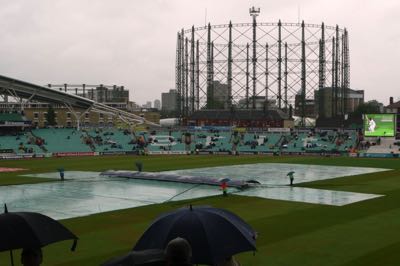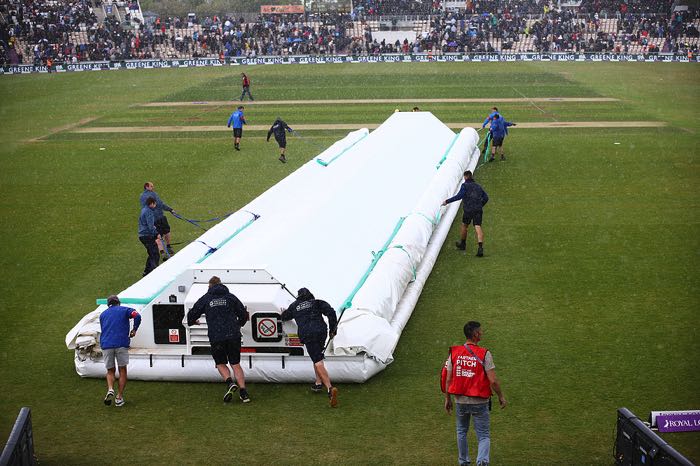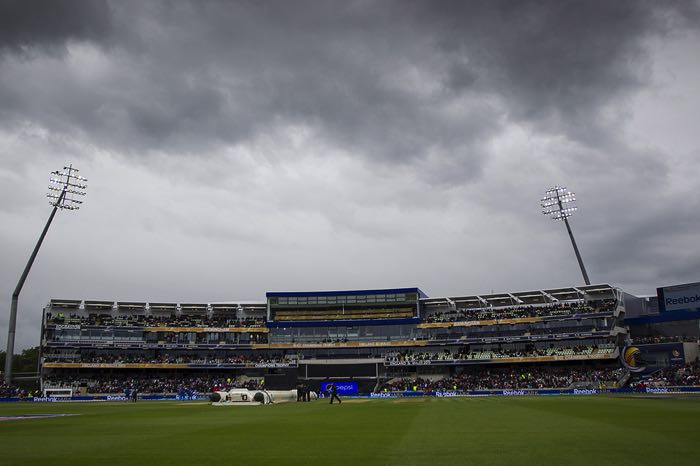
Graham Horn / Wikipedia.org
Although many sports can carry on without too much bother when the heavens open, cricket is not one of them. Fans of rugby and football would perhaps consider cricket to be at the more sensitive side of the spectrum when it comes to dealing with the elements with the players swiftly departing the field of play as soon as the umpires feel a few drops of rain on their hats. It should be noted, of course, that rugby and football don’t involve a hard ball being hurled towards you at speed of 90mph.
Back to cricket though, and given that rain is a fairly regular occurrence (especially in the UK), it stands to reason that many cricket matches end up getting disrupted. If said rain occurs midway through a limited-overs match, that is to say, after only one side has battered, it causes something of a problem when it comes to figuring out which side should be declared the winner. This is why a fair and flexible method to adjust the target score for the team playing second is required. And, that is where the Duckworth-Lewis-Stern method comes in.
Introducing the Duckworth-Lewis-Stern (DLS) Method

Ground staff rush to cover the cricket pitch in rain (sportsphotographer.eu / Bigstockphoto.com)
In Test match cricket, if rain stops the match or reduces the number of overs to the point at which neither side is able to win in the remaining time, the match ends as a draw. This is not the case in limited overs matches (such as one day internationals or Twenty20 matches).
Factors for Consideration
Imagine a scenario in which the first team to bat in a limited overs game has completed their innings and been able to face the required number of overs (for example, 50 overs). Just as the second team comes in to bat, the rain begins and there is a delay that means they effectively lose 20 of their 50 overs (based on the allocated time for the match). If they were then required to score one more than their opponents to win the game, it would clearly be unfair as they’d have to reach that target in 30 overs rather than 50.
When it comes to adjusting the target score of the chasing team, it is not as simple as just reducing the runs in proportion to whatever overs are left. There are many factors that need consideration, for example, if the batting team has 15 overs left with nine wickets, they would take more risks in their game when as opposed to the team having 50 overs as they would need to strategically spread their batsmen throughout the game.
Created by Frank Duckworth & Tony Lewis
This is where the Duckworth-Lewis-Stern or the DLS, also previously commonly referred to as the D/L system, comes in handy. It is a sophisticated system that takes these things into account before coming to a conclusion for the reduced target in a rain-affected match. Created by the noteworthy English statisticians, Frank Duckworth and Tony Lewis, it is the mathematical formula, or more accurately system, that calculates target scores when limited-overs matches are shortened due to rain.
First deployed in 1997, the DLS method is quintessential to the game. This is because it is not always possible to shift the match and re-schedule it for the next day due to logistics, availability and other technical reasons. Not to mention, it will have an adverse effect on TV advertisements, stadium tickets and more.
DLS Considers Most Parameters
However, in many countries, rain and possibilities of unpredictable, intemperate weather are high and therefore, a system that is fair and as accurate as possible is required. Of course, no methods or formulae are simply going to be perfect in every scenario because, ultimately, cricket can be a highly unpredictable game that can be changed in an instant from one good ball or one loose shot.
It is agreed, however, that the DLS considers the most parameters most reasonably while coming to a solution to the problem of setting targets in rain-affected games. It is neither side’s fault when rain interrupts play which is why the target score of the second team to bat must reflect both teams’ efforts properly and return a fair score to chase. The DLS does just that – or at least gets closer to that situation than anything that came before it.
Naming the System
As mentioned, the Duckworth-Lewis-Stern (or DLS) method was originally created by two statisticians, Frank Duckworth and Tony Lewis. Thereafter it was called the Duckworth-Lewis system or the DL method. Ever since its implementation by the ICC, it has received several updates.
Steve Stern Adds Further Input
Right before the 2015 World Cup, Professor Steve Stern an Australian scholar from the Statistics Department of the Queensland University of Technology made some updates to the formula which helped it handle higher scores much better, recognising that teams should instead increase their scoring rate as they begin playing and not keep wickets in hand. Then, he became the “custodian” of the formula and his name was added to the official title when the original pair of statisticians retired, thus creating the Duckworth-Lewis-Stern method.
Table Updated Every Year
The DLS works essentially on a formula and a table that reinforces the D/L method (this has now changed to retrieving data from a computer). In an interview with Simon Sherwood, Professor Steve Stern informed that this table is updated on the 1st of July every year. It received updates in 2004 when an apparent flaw in the method was noticed by Tony Lewis as the calculations seemed unfair for very high scoring teams. Some more updates were installed in 2009 for Twenty20 games as careful reconsiderations were needed for the method to be more effective for this format of the game. And, finally, in 2015, the D/L became the DLS method with the addition of Professor Stern’s updates and input.
The Mathematics & Theory Behind Duckworth-Lewis-Stern

Rain at the Edgbaston Stadium (sportsphotographer.eu / Bigstockphoto.com)
The DLS, formerly known as the D/L method, works on the calculations of “resources”. It considers two resources for each team, namely the number of overs they will receive and the number of wickets they have in hand to chase the target score. The D/L exploits a correspondence that has historically been proven to be true between the overs and the wickets that a team has at any point in the innings.
At the start of each innings, the batting team has all of its resources. That is, 10 wickets and, for instance, 50 overs (in a 50-over match). The DLS method reflects these resources as percentages at any point in the innings. It also determines how much of the resources are worth what percentage at each time during the innings based on data derived from many matches and stored in a non-exhaustive table. On the 1st of July of each year, data collated over the previous year is added to the table to ensure it stays up to date and hence relevant.
The Formula
The resources of each team do not deplete constantly but take in an exponential curve. Therefore, the DLS method looks into the resources available to the team before the interruption to calculate the target score. It simply calculates the runs the batting team should score if both the teams had equal resources at any given point. Equating the same in a mathematical formula, it looks something like this:
Team 2’s expected score = Team 1’s score x (Team 2’s resources/Team 1’s resources)
The expected score of the team is basically the score that the chasing team should have reached before an interruption taking into account the wickets they had left. The target score is calculated and the chasing team would require to reach that target to win when the game resumes after an interruption. The specific mathetics of the methods can get a little complicated so we won’t delve too much further into all that. But it could be useful to give an example.
Consider that the rain interrupts a match for the chasing team. The first team scored 213 runs with all of their resources being used up by the final ball of the innings (50 overs and 10 wickets). The batting team only has 80% of their resources. So, the team’s par score would be: 213 multiplied by (80/100), which is 170.4. Now, in case the target is a non-integer number, which happens often, the scores are rounded up to the next number for the team to win. As such, in this case, the second team would need 171 runs to win the match and 170 to tie it.
Famous Examples of the DLS Method in Action

Here we take a further look at some of the most famous examples of the DLS method in action:
2008: England & India
When England faced India in the fourth ODI match during the 2008 series the use of the DLS method was required when the match was interrupted in the first inning while India were batting and the match was reduced to 22 overs each. India had scored 166/4 from their overs and the DLS indicated that England should score 178 runs in their 22 overs to win.
It was widely expected that England would be able to knock off that total in the 22 overs at their disposal. England only scored 168 by the end of the 22 overs, however, and the match result was that India won with the record showing they defeated England by 19 runs (D/L Method).
2006: India & Pakistan
The first ODI in the 2006 series between India and Pakistan was interrupted in the second innings. India’s score were all out for 328 and Pakistan had chased 311 with only 18 runs more to score in 18 balls. The match was interrupted in the 47th over and the D/L method showed a calculated target score of 305. The match therefore resulted in Pakistan winning the game by seven runs.
2011: South Africa & India
Similarly, during the 5th ODI between South Africa and India in 2011, rain reduced the match to 46 overs each. The interruption happened during South Africa’s batting innings and they had scored 250/9 in 46 overs. The adjusted score for India was 268 in 46 overs. It turned out India were bowled out for just 234 though, from 40.2 overs, so South Africa won by 33 runs.
2014: Sri Lanka & England
There have been instances of the target score being lower than than scored by the first team to bat. For example, the match between Sri Lanka and England on 3rd December 2014 was interrupted and the game started with each side having 35 overs each. Sri Lanka had scored 242/8 but England’s target score was calculated to be just 236. This is because, Sri Lanka used up its resources quite early in the game by going a wicket down in just two overs, which amounted to 8% of the overall resources at their disposal.
2011: India & England
D/L scores also ended up with a tie during the India versus England ODI on the 11th September 2011. The game was interrupted by rain several times and each time the game halted, the D/L scores reflected a different scenario. When the game was first interrupted, the D/L calculated that India would win but as the game resumed, England focused on getting ahead on the DLS system and scored some quick runs which was reflected in the calculations the next time they were called upon. The game was called off for good with only seven runs remaining and England’s scores were equal to DLS method’s calculated expected score, hence a tie was declared.
Previous Methods & Why They Were Discarded

The initial matches of ODI (One Day International) cricket used the Average Run Rate or the ARR method to solve target scores when the games were interrupted. This method was one of the simpler methods that just took into account the average run rate of the team batting first. It would calculate how many runs the chasing team would make in the reduced number of overs given if they matched the run rate of the first team.
Average Run Rate Method (ARR)
To give an example, suppose the first team 250 runs with an ARR of 5 runs per over (in 50 overs) and the match is interrupted, cutting the final overs for the chasing team to 20. Then they would only need to make 100 runs to win the match. There are plenty of flaws with the ARR method. For instance, it doesn’t consider how many wickets the first team lost and it is fairly easy to maintain a good run rate over a lesser number of overs given the side batting second can throw caution to the wind and take more risks with all of their wickets in to keep up a higher run rate.
Most Productive Overs Method (MPO)
The second method that was in use before the DLS was implemented is called the Most Productive Overs method or the MPO Method. Australia came up with the MPO method. It reduced the target score for the chasing team by calculating the runs the first team scored in the most productive number of overs which equated with the number of overs lost by the chasing team. If Team B was reduced to 35 overs due to interruption, then their target score would be reduced to whatever runs Team A scored in their most productive 35 overs. The MPO replaced the ARR method in 1991 and was used until 1998.
The Underlying Flaws of the ARR & MPO Methods
Both the ARR and the MPO methods had major flaws in them and they were regularly criticised by players, pundits and fans. The ARR method favoured the chasing team by setting a score based on the run rate which was fairly simple to maintain with all the wickets in hand. While the MPO method was unfair for the team batting second as it considered only the best overs. In that case, their best bowler’s efforts were not at all accounted for. Not to mention, all of the maiden overs that the team bowled were effectively flushed down the drain as the target score would be intact based on the best scoring overs only. It was like the chasing team was being punished for bowling well.
MPO’s flaws were highlighted in the 1992 match between England and South Africa. South Africa only needed 22 runs from 13 balls. The rain stopped the match for 12 minutes and 2 overs were lost, using the MPO method, the scoreboard flashed that South Africa needed 22 runs… off just 1 ball!
DLS Method Extremely Crucial to Cricket
Unpredictable weather conditions are part and parcel of the game of cricket. No matter what, the game cannot be shifted indoors (despite one or two suggestions otherwise), which is why the DLS method is an extremely crucial part of the game. Many teams and matches suffered before the implementation of DLS method in relation to unfair targets being set.
Every year as scoring trends change the DLS is updated and this is one of the best features that sets this method apart from other methods that have been used in the past to calculate target scores. DLS is a sophisticated calculating method that factors in most of the parameters and it is definitely here to stay with more updates and improvement coming in every year.
